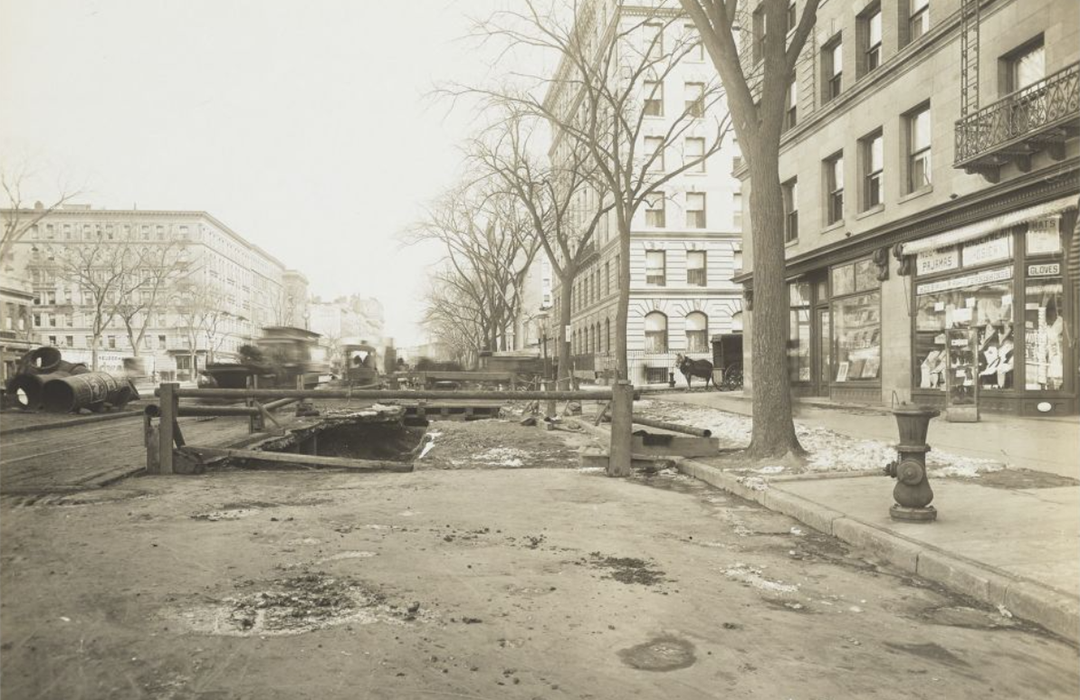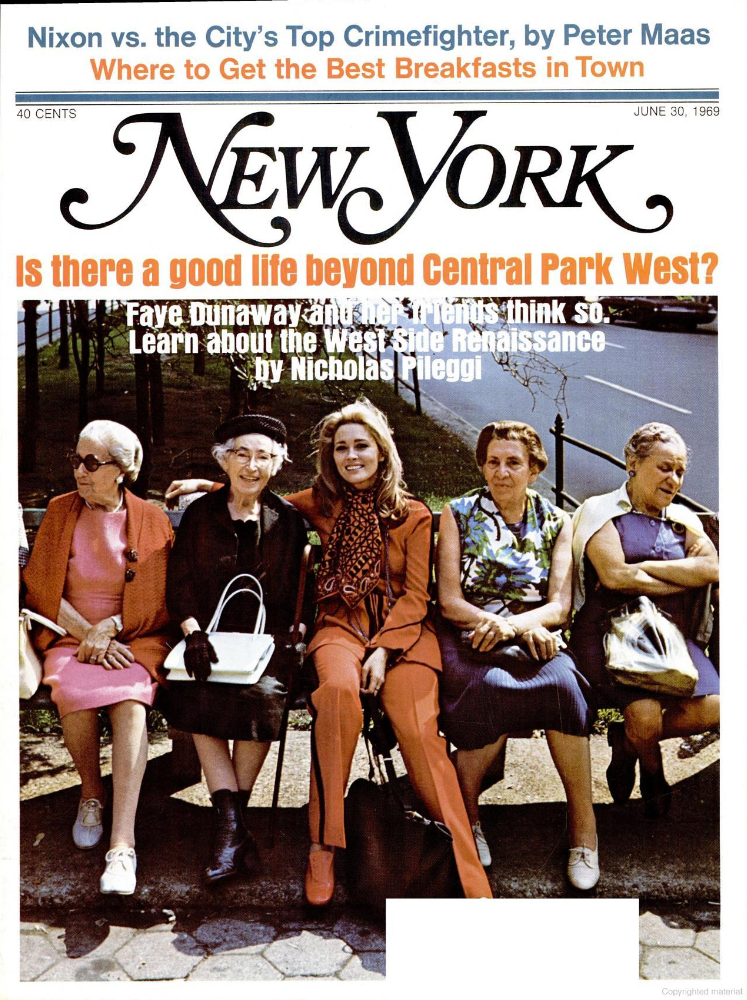
View of Broadway looking north near 2566 Broadway; Image Courtesy NYC Transit Museum, via New-York Historical Society. ca. 8 March, 1909.
The Broadway Malls
by Tom Miller
Until 1811, the year the Commissioner’s Plan was released, Broadway stretched as far north as 10th Street, where it merged with the Bloomingdale Road. That winding roadway took travelers north as far as 147th Street (where it became the Kingsbridge Road). Beginning in 1838 the Bloomingdale Road was “restored” in sections. In each instance, the section was straightened and improved. The stretch from 10th to 43rd Street was addressed in 1838; in 1847, the restoration extended to 71st Street; and in 1851, the work continued to 86th Street.
In 1865, a major overhauling of the Bloomingdale Road took place. It was “restored” to Sputen Duyvil Creek in northern Manhattan. That year, all the roadway south of 59th Street became Broadway, and the section above 59th Street became The Boulevard (sometimes called Western Boulevard.) Although the development of the West End would not begin with vigor until the 1870s, The Boulevard was widened, and landscaped medians were planned.
It ended up in the State Supreme Court, which ruled that the Commissioners of Central Park had control (and responsibility) over the Boulevard.
The concept of parklike medians hit a snag when various city departments argued about which should pay the costs. It ended up in the State Supreme Court, which ruled that the Commissioners of Central Park had control (and responsibility) over the Boulevard. The Park Commissioners seem to have been disgruntled by the additional hit to their budget. On May 30, 1874, The New York Times headlined an article, “The Boulevard Planting,” and reported on a heated letter to the Department of Finance from the Commissioner of Public Works, George M. Van Nort. He complained that the “laborers, &c., employed in planting trees on the Boulevard” had not been paid since December 14, 1873. He promised that prompt payment would avoid “unnecessary litigation.” The Finance Department responded that the Parks Commissioners had made “no appropriation…for planting trees on the Boulevard.”
The inter-departmental feud was eventually settled, and the malls of the Boulevard became picturesque mini parks with trees, flowers, benches, and, in some cases, handsome Victorian drinking fountains. The Upper West Siders’ pride in the medians was evidenced when the League of American Wheelman planned a city-wide parade of bicycles for June 5, 1897. Parks Commissioner Collis altered the route from the Boulevard to Amsterdam Avenue. On April 7, The New York Times explained, “The Commissioner’s contention was that the grass plots and flower beds in the centre [sic] of the great drive would be ruined by the presence of a big crowd such as would turn out to see the cyclist in line.”
Two years later, The Boulevard was renamed Broadway. And the beauty of its malls was soon to be devastated. In 1902, construction began on the extension of the Interborough Rapid Transit subway up the middle of Broadway through the Upper West Side. The terms of the city’s contract with the I.R.T. said, “the builder was allowed to tear up the trees on condition that he would plant more, the new ones to be 3-1/2 inches in diameter and not less than 15 feet high,” according to The New York Times on January 7, 1903. Instead, as the Park Commissioners discovered, the excavations were refilled with “tin cans, mortar, and other debris,” according to the article, which added, “Investigation showed that the ‘soil’ was composed of rubbish largely, with a good deal of hard rock thrown in.” In addition, Commissioner Willcox, “looked along the line, and saw small, scrubby-looking trees planted on the blocks in which the tunnel work was finished.” Willcox commented, “the planting of trees by the rapid transit contractors along the line of the Boulevard has been absolutely worthless.” The I.R.T. agreed to remove all the infill, replace it with fertile soil, and plant particular species of trees that would grow atop the tunnel, needing only a few feet of earth for their roots.
The arrival of the subway along Broadway demanded stations. Two added to the beauty of the malls—the handsome Flemish Revival structure at 72nd Street and the more Renaissance-inspired station at 96th Street, both completed in 1904.
“the planting of trees by the rapid transit contractors along the line of the Boulevard has been absolutely worthless.”
Three years after the Parks Commissioners battled with the Interborough Rapid Transit, Upper West Side residents were frustrated enough to take matters into their own hands. Elizabeth Clark Potter, the wealthy widow of Alfred Corning Clark and current wife of Bishop Alonzo Potter, spent her own money on landscaping the mall between 87th and 88th Streets. Robert T. Elder, who lived on West 78th Street, told The New York Times, “There the plants and grass have made it a beauty spot in comparison with the bare strip that is regarded by property owners as ‘a disgrace to the city.’”
On November 11, 1906, The New York Times reported:
With a view to having the centre of Broadway from Fifty-ninth Street to 116th Street beautified by the city, instead of waiting for the Inter borough Company to replace the trees it destroyed in the construction of the Subway, a number of influential property owners and taxpayers along that section of the thoroughfare have formed themselves into a league.
The article said, “The plan of the league is to have the strip fenced and the interior planted with shrubbery and grass. The Municipal Art Association has already asked that it be allowed to inspect any designs made for the improvement.”
Maintaining the microparks demanded constant vigilance. On January 2, 1911, The New York Times reported, “Many complaints have been received by the Park Department in regard to the neglected condition of the parkway.” In response, Park Commissioner Stover announced, “the work of beautifying Broadway from Sixtieth Street to 110th, by planting shrubs in the parkway in the middle of the thoroughfare, would be begun immediately.”
The last quarter of the 20th century was as dark for the Broadway malls as was the first quarter. The city’s financial crisis in the 1970s halted the maintenance of park spaces. Central Park, Union Square, and Verdi Square became notorious, the latter two known as “needle parks” for unchecked drug use. The Broadway malls were overgrown and litter-filled. Then, as had happened in 1906, the community stepped in. In 1980, Eugene Hide spearheaded the formation of the Broadway Mall Association to beautify and maintain the medians. Working in cooperation with groups like the Lincoln Square Business Improvement District, the BMA plants bulbs, installs art exhibitions, and maintains the malls in general.
Tom Miller is a social historian and blogger at daytoninmanhattan.blogspot.com
Keep Exploring
Keep Exploring
Be a part of history!
Think Local First to support the Nonprofit maintaining the Broadway Malls:
Meet Ian Olsen!



